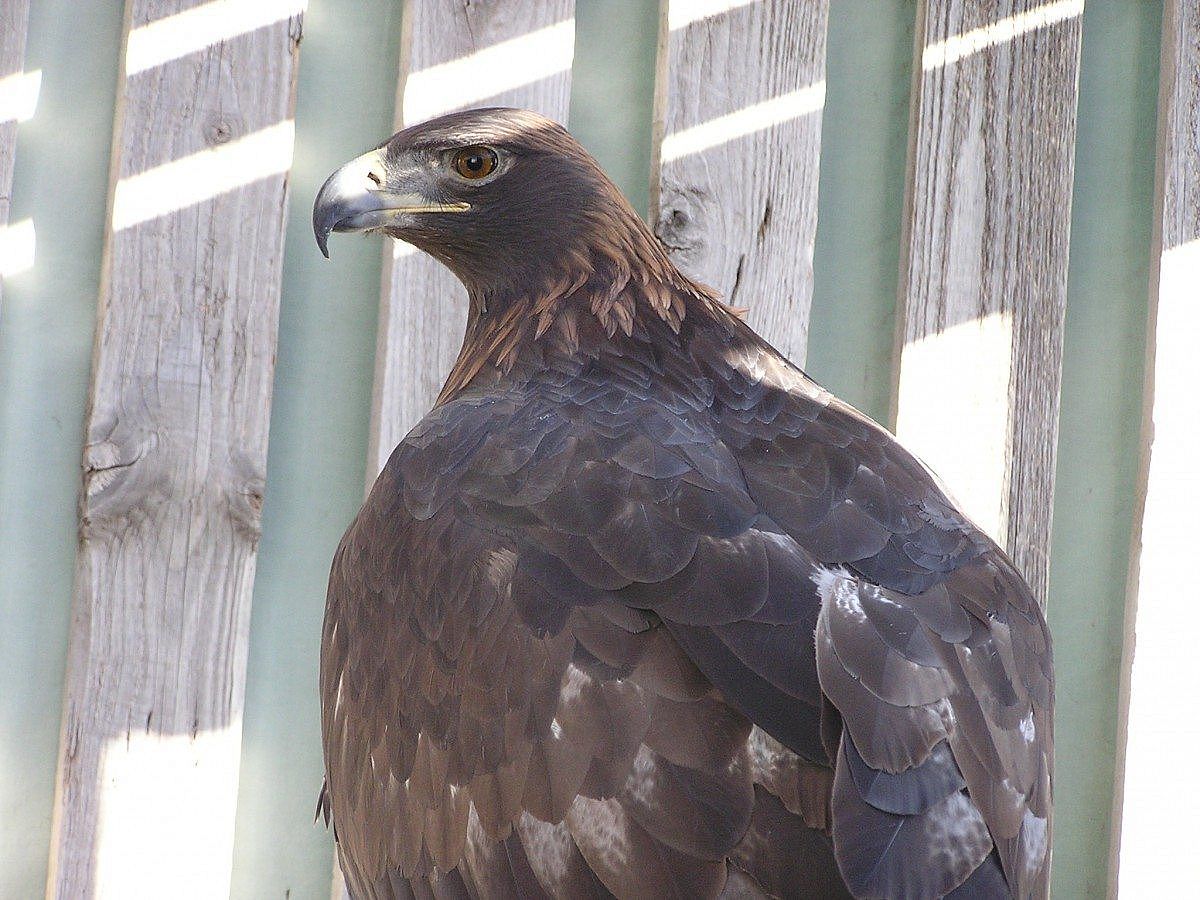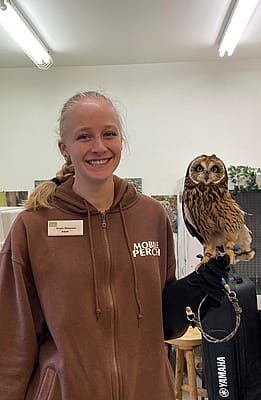
Excitement! A golden eagle
Okay, I know I’ve missed a blog or two, but there’s a REALLY good reason for it. We’ve gotten our golden eagle!
We’ve been hoping to add a golden eagle to our program since the very beginning, but it’s not an easy accomplishment. The process for an eagle is much more involved than that for the other raptor species and they don’t come available for placement very often.
Our local avian rehabilitation center, Ironside Bird Rescue, has known about our desire to have an eagle but hasn’t had one for placement since we’ve been up and running. One day I noticed that they had a male that was going to be non-releasable and I contacted Susan, the director, right away. Unfortunately, I was the third person in line for the eagle—which meant I wouldn’t get him. Susan mentioned, however, that the rehabber in Gillette had two that were going to be going somewhere else but the arrangement had fallen through. I immediately called the Northeast Wyoming (NEW) Bird Rescue to inquire about the birds. It was true! Diane, the director, and I talked about what we were looking for, my previous experience, our facilities, and our program.
It turns out I had a choice of an immature male with head trauma or an adult female with wing damage. Diane told me to think about it over the weekend and call her back. There really wasn’t much to think about on my end. I preferred the female. While a male would be smaller (an advantage to my volunteers who’ve never worked with such large raptors), a female is much more “imposing” and makes an amazing impression. The female Diane had was described as incredibly mellow and easy going while the male was a bit skittish. In reality, it’s easier to deal with a large but calm bird than it is to deal with a smaller but high strung bird.
I called Diane back and we worked out an agreement that the female would be ours. Pending approval from both the Wyoming Game & Fish Department and the U.S. Fish & Wildlife Service, of course. I had been working on my federal application for over a year and really only needed to add the information for the eagle and rehabber and do some proof reading. In early November, I sent off the application. And now we wait…
Fortunately, the Wyoming Game & Fish Department had authorized an eagle for us a while back so it was only one agency we were waiting on. It was an agonizing two months. In early January I received a call from our U.S. Fish & Wildlife Permit representative. He needed some more information about our application. They were looking at it! This was getting exciting! At around 10 a.m. on January 17 we finally received word that we’d been approved!
A whirlwind of activity occurred instantly! The volunteers were informed. I called Diane to let her know we were approved and discuss a good time to arrange a pick up. We did our best to keep the whole thing hush-hush, but it didn’t work. The next Monday I was off to collect our new eagle. After eight-and-a-half hours in the car, I returned with an eagle.
Our first task was to get her out of the box she traveled in and examine her briefly before putting her new equipment on. Dr. Charles Preston, Founding Curator of the Draper Natural History Museum, Golden Eagle researcher and author, and my boss, was called in for his expertise in holding the bird while I affixed her equipment.
We held our breath as we opened the cardboard box for our first glimpse at her. I realize it sounds silly to transport an eagle in a flimsy cardboard box, but they actually work wonderfully for wild birds. They are smooth so they don’t ruffle feathers, surprisingly durable, and you can throw them away when done rather than have to clean them. Our first impression of her was pure awe. They are magnificent animals and we were expecting a relatively small female, maybe 10 or 11 pounds. One look at her feet and we knew we did not have a small girl. She was BIG! We had already weighed the box with her in it and when the box was weighed without her it proved she was a big girl: 13 pounds!
She was incredibly mellow for the entire process of lying her down and placing leather straps, called anklets, around her legs. After they were fitted, her jesses were put on, followed by swivels and the leash (Anne wrote a whole blog about this so I won’t bore you with details).
Now that she was “dressed,” it was time to put her in her mew and let her get settled in. Her room currently has all the windows covered to provide her with a dark and quiet place. This is critical in the initial stages of training a raptor as they are so dependent on their vision that overstimulation can make them more nervous and cause them to associate bad things with their new home—which we didn’t want. She will be in this room until she is “manned” or comfortable standing on the glove and moving about. All her initial training is done in here and it’s a system that falconers have used for thousands of years.
I know most of you are wondering when you’ll be able to see her. Well, that depends on her. We are taking her training at her pace. As soon as she is comfortable enough to face the public, we’ll bring her out. In the meantime, you’ll just have to keep reading the blog for more updates :).
Written By
Melissa Hill
While earning her Bachelor's Degree in Wildlife Management at the University of Wyoming, Melissa began volunteering at Laramie Raptor Refuge and was instantly hooked on birds of prey. Since those early days, she has worked with nearly 70 different raptors at four different raptor education groups in three states. She is a former member of the Education Committee for the International Association of Avian Trainers and Educators (IAATE) and a National Association for Interpretation's Certified Interpretive Guide. When she's not "playing with the birds" she enjoys spending time quilting, crocheting, and exploring the Greater Yellowstone Ecosystem with her non-bird family.


















